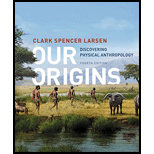
Concept explainers
Introduction: The genus Homo comprises modern humans as well as their close relatives. This genus is defined by certain behavioral as well as physical characteristics such as the small face, small jaws, and large brain.
Answer to Problem 1SQ
Correct answer: Option d) short legs relative to arms
Explanation of Solution
Reasons for the correct answer:
Option d) is given as “short legs relative to arms”.
Most of the anatomical characteristics differ between early australopithecine species and Homo habilis. The early australopithecines had a huge chewing complex and small brain. But the chewing complex of Homo habilis was smaller and the brain was large. The legs of Homo habilis were short relative to their arms and this feature was similar to the early australopithecine species.
Hence option d) is correct.
Reasons for the incorrect answers:
Option a) is given as “a small brain”. The early australopithecines had a smaller brain but the brain of Homo habilis was larger. Hence, option a) is incorrect.
Option b) is given as “a large chewing complex”. The early australopithecines had a huge chewing complex but the chewing complex of Homo habilis was smaller. Hence, option b) is incorrect.
Option c) is given as “a large face and large jaws”. The anatomical characteristics such as large jaws and large faces were found in early australopithecines whereas Homo habilis has face and jaws smaller than early australopithecines. Hence, option c) is incorrect.
Therefore, options a), b), and c) are incorrect.
Therefore, the anatomical characteristic that was similar between the earliest australopithecine species and the Homo habilis was legs that are shorter when compared to arms.
Want to see more full solutions like this?
Chapter 11 Solutions
Our Origins: Discovering Physical Anthropology (Fourth Edition)
- Why are plesiadapiforms most likely the earliest primate ancestors? A. They do not have a postorbital bar or plate B. Their eyes are forward-facing C. They have grasping fingers D. They have clawsarrow_forwardWhat is one anatomical difference between Australopithecines and other early hominins, such as Ardi? A. There were no anatomical differences between Ardi and the Australopithecines. B. Ardi had a divergent big toe while the Australopithecines had non-divergent big toes. C. Australopithecines had more facial prognathism than Ardi. D. Australopithecines had larger canines than Ardi.arrow_forwardCephalopods have complex eyes that arose separately from vertebrate eyes that are also used in vision. What's this an illustration of? A. Analogous structures B. Vestigial structures C. Homologous structures D. Missing linksarrow_forward
- Hominins naturally prefer which types of foods? a. bitter b. sweet and salty c. spicy d. tart and crunchyarrow_forwardWhat is one trait related to locomotion that Au. sediba shares with chimpanzees? A. Long arms and curved fingers B. A broad, wide pelvis C. An S-shaped spine D. Angled femursarrow_forwardWhat is one trait related to locomotion that Au. sediba shares with modern humans? A. Angled femurs B. Longer arms and shorter legs C. Long and thin pelvis D. A divergent big toe (big toe sticks out)arrow_forward
- What is the closest common ancestor of the Allosaurus and Aves? A. Maniraptora B. Theropoda C. Dramaeosauridae D. Dinosauriaarrow_forwardWhat is one anatomical trait that is present in both Adapoids and Omomyoids? A. A bony ear tube B. Very large eyes C. Postorbital bar D. A large body sizearrow_forwardAccording to "Life and Death 3MYA", what kind of tools did Lucy and other Australopithecines most likely use? A.An advanced stone tool like the Acheulean hand axe B.A bow and arrow C.A crude stone tool like the Oldowan Chopper D.Wheelbarrowarrow_forward
- According to "Life and Death 3MYA", what kind of tools did Lucy and other Australopithecines most likely use? A.Wheelbarrows B.A crude stone tool like the Oldowan Chopper C.A bow and arrow D.An advanced stone tool like the Acheulean hand axearrow_forwardAccording to "The Life and Death of a Neanderthal (Shanidar 1)”, what is the evidence that suggests that Neanderthals might have buried their dead? A.There is actually no evidence that Neanderthals buried their dead B.Some of the bodies were buried in caskets C.The bones of the individuals seemed to have been deliberately thrown and dispersed throughout the cave D.Bodies were buried near each other and plant remains were found in their gravesarrow_forwardWhich of the following is one of the main tendencies observed in early hominins, such as australopithecines? A. Decrease in the number of incisors B. Reduced canine size C. Increased facial prognathism D. Increased diastemaarrow_forward
